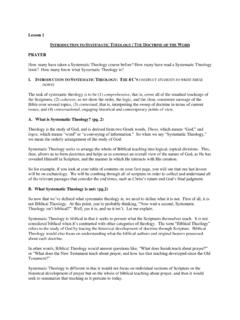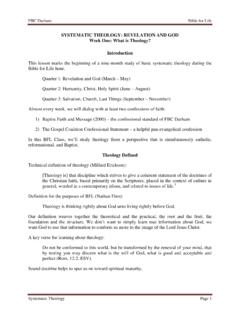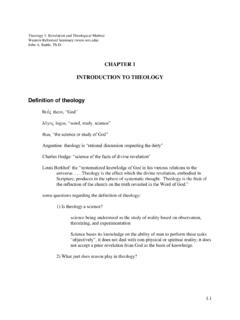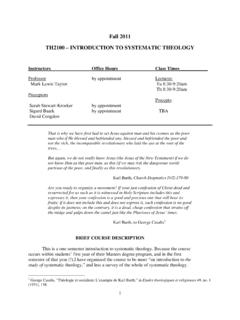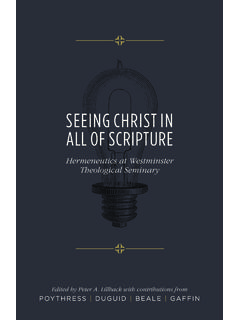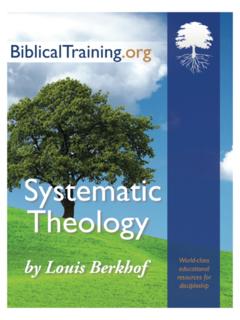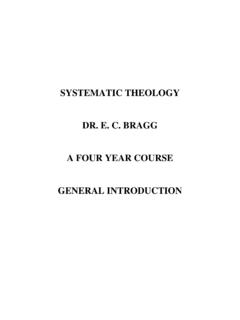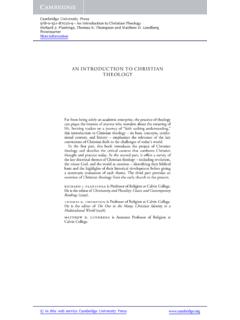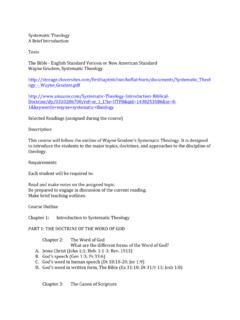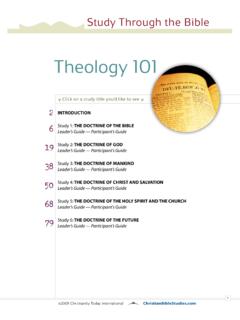Transcription of Course Syllabus THS 510 L02.A Systematic Theology I
1 1 Course Syllabus THS 510 Systematic Theology I Dr. Everett Berry Email: Professor of Theology Office phone: Fall 2016 Credit Hours: 3 _ _____ Course DESCRIPTION This Course provides advanced discussions to Theological Method (Prolegomena), Scripture (Bibliology), God ( Theology Proper), Creation, Providence, Angels (Angelology), Humanity (Anthropology), and Sin (Hamartiology), defining the scriptural views and showing the arguments for them, refuting other views, and emphasizing the relevance of Theology to the Christian life and witness.
2 (Prerequisites may be taken concurrently: NTS and OTS introduction courses per degree program requirements, BIB 505 Hermeneutics) LEARNING OBJECTIVES This Course is designed to introduce students to the aforementioned areas of Christian Theology . While it is based upon the lecture format, it also will include reading, research, and interaction. Furthermore, at the end of this Course , the student should demonstrate the ability Graduate Instruction Learning Outcomes: 1. Defend the major ideas that the Scriptures emphasize regarding these doctrinal subjects. 2. Recognize and define the pertinent issues, fundamental terms, and theological categories that are used when discussing these doctrines within the context of Systematic Theology .
3 3. Explain the divergent views that have evolved in the history of these doctrines. Independent Study and Research Outcomes: 4. Demonstrate proficiency in articulating the ways in which these doctrines interrelate to each other as well as the Christian faith as a whole. 5. Integrate the main ideas of these doctrines to their lives in such a way that they will impact their personal walk with the Lord. 6. Discuss these doctrines with people in the local church setting in an accessible manner. Course TEXTS * The Bible: The professor typically uses the New American Standard or English Standard Version in written lectures. * Allison, Gregg R.
4 Historical Theology . Grand Rapids: Zondervan, 2011. * Craig, William L., et al. Four Views of Divine Providence. Grand Rapids: Zondervan, 2011. * Grudem, Wayne. Systematic Theology . Grand Rapids: Zondervan, 1995. * Lamoureux, Denis O., et al. Four Views on the Historical Adam. Grand Rapids: Zondervan, 2013. Course REQUIREMENTS Textbook Reading Assignments (20%) 2 The approximately 1,300 pages of required textbook reading are a crucial component of this Course . As the class progresses, it is expected that students will read the assigned pages thoughtfully and according to the order given on the Course Schedule. Likewise, by the end of the semester, students will be required to report the percentage of reading that has been completed.
5 (This is only to be done once by the end of the semester.) To do so- 1. Students are to click the Course Material hyperlink which is the fourth one located in the left column of the Blackboard homepage. After entering this section, students can then click into the Week 8 hyperlink. 2. After entering the Week 8 site, students can then click the Textbook Reading Report icon and then click the Begin Button to enter the Reading Report page. 3. Next, students can see the total number of chapters and pages listed. They are to record their total percentage of pages read in the response box and finally click the Save and Submit Button to upload their answer for grade credit.
6 4. Also note that if all of the reading has not been finished, students will only receive credit for the completed percentage that they report. Bible Reading Assignments (10%) The biblical passages listed in the Course schedule are another crucial reading component of this Course . Ideally, students are to read these assigned biblical texts before engaging the related lectures. At the end of the term, students will be required to report the percentage of Bible reading that has been completed. (This is only to be done once by the end of the semester.) To do so- 1. Students are to click the Course Material hyperlink which is the fourth one located in the left column of the Blackboard homepage.
7 After entering this section, students can then click into the Week 8 hyperlink. 2. After entering the Week 8 site, students can then click the Bible Reading Report icon and then click the Begin Button to enter the Reading Report page. 3. Next, students can record their total percentage of passages read in the response box and finally click the Save and Submit Button to upload their answer for grade credit. 4. Also note that if all of the reading has not been finished, students will only receive credit for the completed percentage that they report. Lecture Reading Assignment (5%) Students are required to read the written lectures that cover the topics of the class.
8 This is why the Course schedule provided in this Syllabus outlines the order of lectures. To access them, students can click the Course Lectures Hyperlinks that are available in the various weeks of the class. Note that the Course Schedule, which is the third hyperlink on the left side of the Blackboard homepage, provides an outline of the order of lectures for each week; , Week 1: Lectures 1-3; Week 2: Lectures 4-6, etc. Finally, similar to the textbook reading assignments, by the end of the semester students will be required to report the percentage of lectures that have been read. (This is only to be done once by the end of the semester.)
9 To do so- 1. Students are to click the Course Material hyperlink which is the fourth one located in the left column of the Blackboard homepage. After entering this section, students can then click into the Week 8 hyperlink. 2. After entering the Week 8 site, students can then click the Lecture Reading Report icon and then click the Begin Button to enter the Reading Report page. 3 3. Next, students can see the total number of lectures listed. They are to record their total percentage of lectures read in the response box and finally click the Save and Submit Button to upload their answer for grade credit. 4. Also note that if all of the lectures have not been finished, students will only receive credit for the completed percentage that they report.
10 Discussion Board Participation (15%) Students will participate in three Discussion Board (DB) forums, each spanning across two week intervals. In the first week, students will answer the forum question(s) in a new thread of 400 500 words by 11:59 pm of the Sunday night of that assigned week. Then in the subsequent week, students must reply to two classmates threads, in 200 250 words each, by 11:59 pm, the next Sunday night. So in accordance with the Course calendar: Week 1: DB Thread 1 (10/10-10/16) Week 4: DB Responses 2 (10/31-11/6) Week 2: DB Responses 1 (10/17-10/23) Week 5: DB Thread 3 (11/7-11/13) Week 3: DB Thread 2 (10/24-10/30) Week 6: DB Responses 3 (11/14-11/20) To enter the DB forums, students can- 1.


